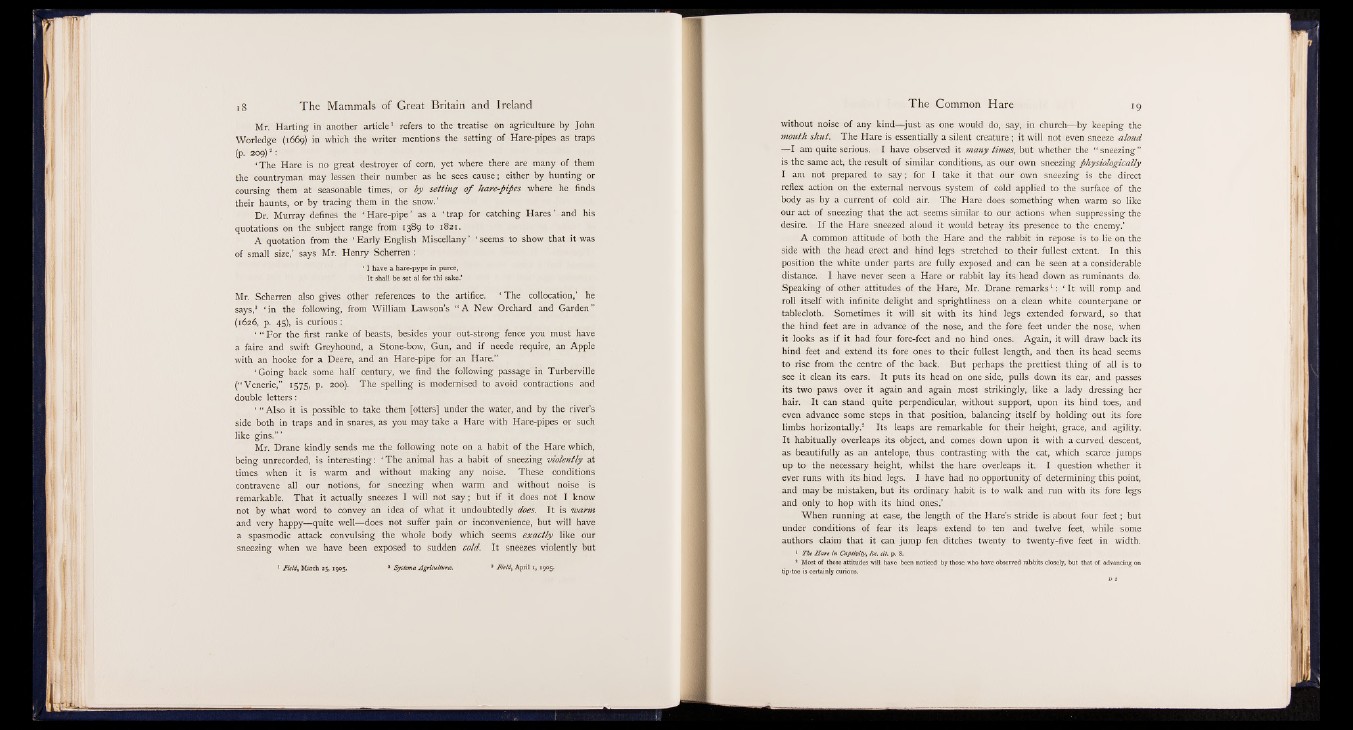
Mr. Harting in another article1 refers to the treatise on agriculture by John
Worledge (1669) in which the writer mentions the setting of Hare-pipes as traps
(p. 209)8:
‘ The Hare is no great destroyer of corn, yet where there are many of them
the countryman may lessen their number as he sees cause; either by hunting or
coursing them at seasonable times, or by setting o f ha re-fifes where he finds
their haunts, or by tracing them in the snow.’
Dr. Murray defines the ‘ Hare-pipe’ as a ‘ trap for catching Hares ’ and his
quotations on the subject range from 1389 to 1821.
A quotation from the ‘ Early English Miscellany’ 'seems to show that it was
of small size,’ says Mr. Henry Scherren :
‘ I have a hare-pype in puree,
I t shall be set al for thi sake.’
Mr. Scherren also gives other references to the artifice. ‘ The collocation,’ he
says,8 ‘ in the following, from William Lawson’s “ A New Orchard and Garden”
(1626, p. 45), is curious:
‘ “ For the first ranke of beasts, besides your out-strong fence you must have
a faire and swift Greyhound, a Stone-bow, Gun, and if neede require, an Apple
with an hooke for a Deere, and an Hare-pipe for an Hare.”
‘ Going back some half century, we find the following passage in Turberville
(“ Venerie,” 1575, p. 200). The spelling is modernised to avoid contractions and
double letters:
‘ “ Also it is possible to take them [otters] under the water, and by the river’s
side both in traps and in snares, as you may take a Hare with Hare-pipes or such
like gins.” ’
Mr. Drane kindly sends me the following note on a habit of the Hare which,
being unrecorded, is interesting: ‘ The animal has a habit of sneezing violently at
times when it is warm and without making any noise. These conditions
contravene all our notions, for sneezing when warm and without noise is
remarkable. That it actually sneezes I will not s a y ; but if it does not I know
not by what word to convey an idea of what it undoubtedly does. It is warm
and very happy— quite well— does not suffer pain or inconvenience, but will have
a spasmodic attack convulsing the whole body which seems exactly like our
sneezing when we have been exposed to sudden cold. It sneezes violently but
1 Field, March 25, 1905. * Systema Agriculture. 3 Field, April r, 1905.
without noise of any kind—just as one would do, say, in church— by keeping the
mouth shut. The Hare is essentially a silent creature; it will not even sneeze aloud
B l am quite serious. I have observed it many times, but whether the “ sneezing ’’
is the same act, the result of similar conditions, as our own sneezing physiologically
I am not prepared to s a y ; for I take it that our own sneezing is the direct
reflex action on the external nervous system of cold applied to the surface of the
body as by a current of cold air. The Hare does something when warm so like
our act of sneezing that the act seems similar to our actions when suppressing the
desire. I f the Hare sneezed aloud it would betray its presence to the enemy.’
A common attitude of both the Hare and the rabbit in repose is to lie on the
side with the head erect and hind legs stretched to their fullest extent. In this
position the white under parts are fully exposed and can be seen at a considerable
distance. I have never seen a Hare or rabbit lay its head down as ruminants do.
Speaking of other attitudes of the Hare, Mr. Drane remarks1: ‘ It will romp and
roll itself with infinite delight and sprightliness on a clean white counterpane or
tablecloth. Sometimes it will sit with its hind legs extended forward, so that
the hind feet are in advance of the nose, and the fore feet under the nose, when
it looks as if it had four fore-feet and no hind ones. Again, it will draw back its
hind feet and extend its fore ones to their fullest length, and then its head seems
to rise from the centre of the back. But perhaps the prettiest thing Of all is to
see it clean its ears. It puts its head on one side, pulls down its ear, and passes
its two paws over it again and again most strikingly, like a lady dressing her
hair. It can stand quite perpendicular, without support, upon its hind toes, and
even advance some steps in that position, balancing itself by holding out its fore
limbs horizontally.2 Its leaps are remarkable for their height, grace, and agility.
It habitually overleaps its object, and comes down upon it with a curved descent,
as beautifully as an antelope, thus contrasting with the cat, which scarce jumps
up to the necessary height, whilst the hare overleaps it. I question whether it
ever runs with its hind legs. I have had no opportunity of determining this point,
and may be mistaken, but its ordinary habit is to walk and run with its fore legs
and only to hop with its hind ones.’
When running at ease, the length of the Hare’s stride is about four feet; but
under conditions of fear its leaps extend to ten and twelve feet, while some
authors claim that it can jump fen ditches twenty to twenty-five feet in width.
1 The Hare in Captivity, loc. a t. p. 8.
3 Most of these attitudes will have been noticed by those who have observed rabbits closely, but that of advancing on
tip-toe is certainly curious.